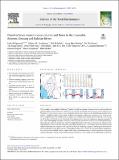Files in this item
Dissolved trace element concentrations and fluxes in the Irrawaddy, Salween, Sittaung and Kaladan Rivers
Item metadata
| dc.contributor.author | Bridgestock, Luke | |
| dc.contributor.author | Henderson, Gideon M. | |
| dc.contributor.author | Holdship, Phil | |
| dc.contributor.author | Khaing, Aung Myo | |
| dc.contributor.author | Naing, Tin Tin | |
| dc.contributor.author | Myint, Tin Aung | |
| dc.contributor.author | Htun, Wint Wint | |
| dc.contributor.author | Khant, Win | |
| dc.contributor.author | Thu, Win Myo | |
| dc.contributor.author | Nay Chi, Mo Aung | |
| dc.contributor.author | Baronas, J. Jotautas | |
| dc.contributor.author | Tipper, Edward | |
| dc.contributor.author | Chapman, Hazel | |
| dc.contributor.author | Bickle, Mike | |
| dc.date.accessioned | 2023-03-20T17:30:03Z | |
| dc.date.available | 2023-03-20T17:30:03Z | |
| dc.date.issued | 2022-10-01 | |
| dc.identifier | 283736719 | |
| dc.identifier | 2fe55e92-5b22-484e-aa91-a31d6a17e716 | |
| dc.identifier | 85132774774 | |
| dc.identifier.citation | Bridgestock , L , Henderson , G M , Holdship , P , Khaing , A M , Naing , T T , Myint , T A , Htun , W W , Khant , W , Thu , W M , Nay Chi , M A , Baronas , J J , Tipper , E , Chapman , H & Bickle , M 2022 , ' Dissolved trace element concentrations and fluxes in the Irrawaddy, Salween, Sittaung and Kaladan Rivers ' , Science of the Total Environment , vol. 841 , 156756 . https://doi.org/10.1016/j.scitotenv.2022.156756 | en |
| dc.identifier.issn | 0048-9697 | |
| dc.identifier.other | ORCID: /0000-0001-7636-6090/work/131122784 | |
| dc.identifier.uri | https://hdl.handle.net/10023/27232 | |
| dc.description | Funding: This work was funded by a Royal Society International Collaboration Award (No. IC160088) to G. M. Henderson. | en |
| dc.description.abstract | The Irrawaddy (Ayeyarwaddy) and Salween (Thanlwin) globally rank among the largest rivers for supplying dissolved and particulate material to the ocean. Along with the Sittaung and Kaladan rivers they have societal importance to Myanmar in terms water sources and food production. Despite their importance for global biogeochemical cycles and the ~50 million people who live in their catchments, the chemistry of these rivers is poorly known. This study presents a comprehensive survey of dissolved (<0.22 μm) trace element concentrations (Sr, Fe, Al, Ba, Mn, V, Rb, Cu, Zn, As, Li, Ni, Mo, Cr, U, Pb, Sb, Co, Cs, Tl and Cd) at 38 locations within these river catchments, spanning a period of 2 years. The results highlight the global importance of the Irrawaddy and Salween rivers for trace element global biogeochemical cycles; contributing between 1 and 17 % of global dissolved riverine fluxes to the land-ocean interface for the studied elements. Area normalized dissolved fluxes in these catchments are ~2 to 10 times higher than global average values for most elements, consistent with high rates of chemical weathering. In general, anthropogenic activities have yet to significantly perturb dissolved trace element fluxes in these river systems. The presented dataset should therefore serve as a useful ‘natural’ baseline, against which future perturbations driven by climate change and/or the development of Myanmar's mining industry could be assessed. Exceptions to this include As in the Sittaung River and Sb, Zn, Pb and As in the Salween River, which may already be significantly impacted by anthropogenic inputs. The former represents a water quality issue of concern for public health, and so constraining the exact sources of As in the Sittaung River should be considered a priority for future research. | |
| dc.format.extent | 13 | |
| dc.format.extent | 2925017 | |
| dc.language.iso | eng | |
| dc.relation.ispartof | Science of the Total Environment | en |
| dc.subject | Riverine trace element fluxes | en |
| dc.subject | Water quality | en |
| dc.subject | Trace element pollution | en |
| dc.subject | Global trace element cycles | en |
| dc.subject | GE Environmental Sciences | en |
| dc.subject | DAS | en |
| dc.subject | SDG 2 - Zero Hunger | en |
| dc.subject | SDG 3 - Good Health and Well-being | en |
| dc.subject | SDG 13 - Climate Action | en |
| dc.subject | SDG 14 - Life Below Water | en |
| dc.subject | MCC | en |
| dc.subject.lcc | GE | en |
| dc.title | Dissolved trace element concentrations and fluxes in the Irrawaddy, Salween, Sittaung and Kaladan Rivers | en |
| dc.type | Journal article | en |
| dc.contributor.institution | University of St Andrews. School of Earth & Environmental Sciences | en |
| dc.identifier.doi | https://doi.org/10.1016/j.scitotenv.2022.156756 | |
| dc.description.status | Peer reviewed | en |
This item appears in the following Collection(s)
Items in the St Andrews Research Repository are protected by copyright, with all rights reserved, unless otherwise indicated.

